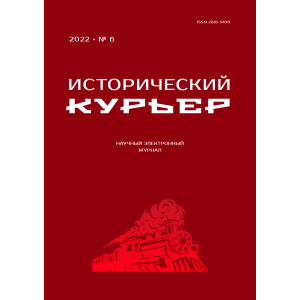“To Live, Think and Speak Soviet”: Soviet Сivilization as a Social and Cultural Phenomenon
This thematic issue of the journal is timed to coincide with the centennial of the formation of the USSR. All the authors of the articles have tried in one way or another to comprehend the phenomenon of so-called “Sovietness” and have paid much attention to the search for the roots and genesis of “the Soviet”, including the project of a “new man”. An important theme of the issue was the study of the language of the Soviet man and his ability to “speak Bolshevik”. The articles, written within the framework of the linguistic turn in history, analyze various discursive practices in the context of the formation of the Russian language of the Soviet type, using the examples of "letters to the authorities", diaries, and artistic texts. At the same time, intensive communication between the authorities and citizens is considered as one of the most important forms of political participation in the USSR. A number of articles are devoted to the processes of transformation of traditional social institutions and roles within the framework of the Soviet project and the formation, along with the Soviet identity, of the widest palette of identities of historical actors. Another significant theme of the issue was the changing sociocultural “habitat” of the Soviet man, including the extreme
conditions of World War II.
 Early Soviet Period
Early Soviet Period
A.P. Kilin
Death of Vladimir I. Lenin in the Assessments of Contemporaries: on the Materials of Information Reports of the District Departments of the OGPU in the Urals
Death of Vladimir I. Lenin is considered in the context of the transition to a peaceful stage of development of early Soviet society. This event was used for propaganda purposes, allowed to consolidate the divided society and ensure the transfer of power in the party leadership. The attitude to the death of the country’s leader, whose cult began to form during his lifetime, is a significant political marker for every citizen. Public opinion in general and the assessment of individual citizens were the object of attention of the political police, since they allowed ’friend-or-foe’ identification of a citizen. Information reports of the OGPU allow not only to analyse public opinion, but also to identify the most acute problems of this period of national history.
Publishing: 28/12/2022
How to cite: Kilin A.P. Death of Vladimir I. Lenin in the Assessments of Contemporaries: on the Materials of Information Reports of the District Departments of the OGPU in the Urals // Historical Courier, 2022, No. 6 (26), pp. 9–28. [Available online: http://istkurier.ru/data/2022/ISTKURIER-2022-6-01.pdf]
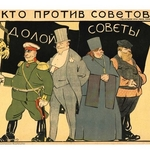 Early Soviet Period
Early Soviet Period
A.A. Kozhaeva
Speech Practices of Imitation of the Official Soviet Discourse in the Petitions of the Deprived to Power (1918–1936) (Based on the Materials of Western Siberia)
The state, which set the purpose of the deprivation campaign to ensure control over potentially alien groups of the population (“former”, merchants and entrepreneurs, clergymen, etc.), achieved this with the help of a set of discriminatory restrictions accompanying disenfranchisement. The problem of studying various categories of deprived, despite a significant number of works devoted to this topic, doesn’t lose its relevance. The question of the possibilities and limitations of adaptation of the deprived in Soviet society requires further in-depth study. The article is devoted to the study of the language used by the deprived in ego documents in an effort to demonstrate their loyalty to the existing system. Based on the analysis of petitions for the restoration of the rights of the deprived of Novosibirsk, as well as the Maslyaninsky and Iskitim districts of Western Siberia, the methods of self-identification of the discriminated with the category of full-fledged citizens of the Soviet society are reconstructed. In order to achieve the restoration of voting rights, the deprived used language constructions that, in their opinion, could lead to a positive decision of the authorities. We have established such specific tactics of the deprived as using the discourse of power to describe their own status, focusing on their real merits to society and the state, not only in the past and present, but also possible in the future. The use of excellent epithets describing the achievements of the state in petitions was an additional way to strengthen the expressions of political loyalty of the deprived to the new system.
Publishing: 28/12/2022
How to cite: Kozhaeva A.A. Speech Practices of Imitation of the Official Soviet Discourse in the Petitions of the Deprived to Power (1918–1936) (Based on the Materials of Western Siberia) // Historical Courier, 2022, No. 6 (26), pp. 29–38. [Available online: http://istkurier.ru/data/2022/ISTKURIER-2022-6-02.pdf]
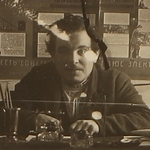 Early Soviet Period
Early Soviet Period
T.I. Morozova
“…He is Dying to Become the Secretary of the Uyezd Committee”. The Struggle for Power in the Kirensky Administrative Division of the Irkutsk Governorate (September – December 1925)
The article studies a history of the struggle for the post of the secretary of the Kirensk uyezd committee of RCP(b) resulted in a serious interpersonal conflict. Based on previously unknown archival documents, it establishes the background, reconstructs the course of events, analyzes the role of the party and Soviet leadership of the Irkutsk Governorate in the development and resolution of the conflict, characterizes the results of this fight. It concludes by arguing that the suicide of N.V. Ovsyannikov, a member of the presidium of the Kirensky uyezd committee, became the tragic culmination of the struggle for power.
Publishing: 28/12/2022
How to cite: Morozova T.I. “…He is Dying to Become the Secretary of the Uyezd Committee”. The Struggle for Power in the Kirensky Administrative Division of the Irkutsk Governorate (September – December 1925) // Historical Courier, 2022, No. 6 (26), pp. 39–54. [Available online: http://istkurier.ru/data/2022/ISTKURIER-2022-6-03.pdf]
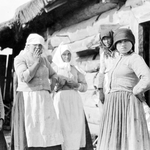 Early Soviet Period
Early Soviet Period
S.P. Kachesova
Transformation of Peasant Woman’s Role in Solving Family Conflicts in the First Third of 20th Century: Consequence of the Implementation of Soviet Project “New Woman” or Echo of the Abolition of Serfdom?
The article presents the results of a study of the ego documents of peasant women of the first third of the 20th century on the basis of methodological approaches to the history of everyday life and gender history. The absence of descriptions by peasant women of family conflicts with men suggests the preservation of the patriarchal foundations of the peasant family throughout the first third of the 20th century. The introduction of the concept of the "new Soviet woman" into peasant life, which began in the 1920s, influenced the transformation of the role of a peasant woman in solving family conflicts later, already in the 1930s. The role of women in resolving family conflicts in the period under study was largely due to the consequences of the peasant reform of the mid-19th century and the modernization processes that followed it.
Publishing: 28/12/2022
How to cite: Kachesova S.P. Transformation of Peasant Woman’s Role in Solving Family Conflicts in the First Third of 20th Century: Consequence of the Implementation of Soviet Project “New Woman” or Echo of the Abolition of Serfdom? // Historical Courier, 2022, No. 6 (26), pp. 55–72. [Available online: http://istkurier.ru/data/2022/ISTKURIER-2022-6-04.pdf]
 Early Soviet Period
Early Soviet Period
V.A. Zhuravleva, M.I. Miroshnichenko
Nuptiality of the Urban Population of the Urals in the Conditions of Industrial Modernization of the Region (1926–1939): Historical and Demographic Aspect
Based on the results of the All-Union population censuses of 1926 and 1939 and current statistics, the article examines changes in the nuptiality of the urban population of the Urals under the influence of the industrial modernization of the region. Based on the analysis of the dynamics of marriages and divorces, the marriage structure and the marital status of urban residents, the authors of the article came to the conclusion, that the emerging changes in marriage could not destroy the values of marriage, still the majority of the urban population was married and had a family.
Publishing: 28/12/2022
How to cite: Zhuravleva V.A., Miroshnichenko M.I. Nuptiality of the Urban Population of the Urals in the Conditions of Industrial Modernization of the Region (1926–1939): Historical and Demographic Aspect // Historical Courier, 2022, No. 6 (26), pp. 73–87. [Available online: http://istkurier.ru/data/2022/ISTKURIER-2022-6-05.pdf]
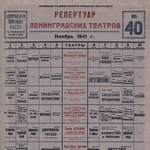 The Great Patriotic War and the Postwar Years
The Great Patriotic War and the Postwar Years
M.G. Gargyants
The Management System of Theatrical and Musical Institutions in Besieged Leningrad (June 1941 – January 1942)
In this article, the task is to analyze the strategy of the management bodies of cultural institutions for the preservation of concert life in besieged Leningrad and at the front. It is concluded that the preservation of cultural life in the city was facilitated by the restructuring of the main tasks of the theater from performances at stationary venues to active military patronage work in the form of field performances.
Publishing: 28/12/2022
How to cite: Gargyants M.G. The Management System of Theatrical and Musical Institutions in Besieged Leningrad (June 1941 – January 1942) // Historical Courier, 2022, No. 6 (26), pp. 88–97. [Available online: http://istkurier.ru/data/2022/ISTKURIER-2022-6-06.pdf]
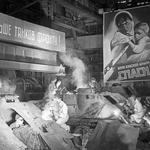 The Great Patriotic War and the Postwar Years
The Great Patriotic War and the Postwar Years
R.E. Romanov
The Many-Faced Fighters of the Rear: Socio-Cultural Types of Motivation of Workers during the Great Patriotic War
The article is devoted to the identification of the socio-cultural diversity of the fighters of the rear by analyzing the processes of formation of five types of motivation for the work of workers of the Siberian defense industry during the Great Patriotic War. The purpose of the research is realized with the help of the author’s concept, within which the analysis of “end-to-end” social and labor cases of world history, used by the Bolsheviks as atypical elements for the construction of the Red Project, is carried out. It is established that in order to consolidate the working personnel in the military industry, the Soviet state introduced both repressive and socio-consumer attitudes to employment in production into new factory collectives, consisting mainly of women and youth with peasant roots. These attitudes were laid in the minds of the personnel of the defense enterprises of Siberia through criminal penalties for official misconduct and the social security system. It is shown that the task of increasing labor productivity was solved by cultivating quasi-monetary, vital and heroic motivation among the defense workers of the region to exceed production standards. These guidelines were formed by them due to an increase in the nominal salary, additional supplies of Stakhanovites and drummers, and the widespread use of moral incentives. It is concluded that in 1941–1945, workers of the leading branches of the military economy acted as carriers of moral imperatives of labor behavior rooted in the archetype, tradition and modernity. The key mental specificity of the fighters of the rear, who became the main personification of the many-faced Sovietism during the period under review, was due to an increased tilt within the Red Project towards both negative (fear of repression) and positive (the desire for survival and glory) archaic, interacting with industrial modernity.
Publishing: 28/12/2022
How to cite: Romanov R.E. The Many-Faced Fighters of the Rear: Socio-Cultural Types of Motivation of Workers during the Great Patriotic War // Historical Courier, 2022, No. 6 (26), pp. 98–109. [Available online: http://istkurier.ru/data/2022/ISTKURIER-2022-6-07.pdf]
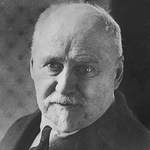 The Great Patriotic War and the Postwar Years
The Great Patriotic War and the Postwar Years
N.N. Melnikov
The USSR Academy of Sciences Plan for the Development of the Power Industry in the Urals During the Great Patriotic War: From Conception to Implementation
During the Great Patriotic War, arms production was moved to the East of the Soviet Union. One of the main industrial centres of the Country was the Urals region. In the autumn of 1941, the Commission for the mobilisation of the Urals economy, headed by V.L. Komarov, president of the USSR Academy of Sciences, began its work in Sverdlovsk. The Commission completed its work by the end of the year. The Commission showed the current state of the Industry in the Urals and made a forecast of the development of the region in 1942. This plan called for a doubling of the Urals industrial potential during the year. In this article, the history of the development of the electric power industry is used as an example to show the difficulty of implementing the plan of the V.L. Komarov Commission. Up to the end of the war period, electricity production was growing, but did not reach the planned level. The energy industry was the basis which was to ensure the development of the Urals economy. During all wartime years, the Urals industry had a shortage of electricity. Therefore, the plan for the development of the industrial base of the Urals was impossible to implement.
Publishing: 28/12/2022
How to cite: Melnikov N.N. The USSR Academy of Sciences Plan for the Development of the Power Industry in the Urals During the Great Patriotic War: From Conception to Implementation // Historical Courier, 2022, No. 6 (26), pp. 110–123. [Available online: http://istkurier.ru/data/2022/ISTKURIER-2022-6-08.pdf]
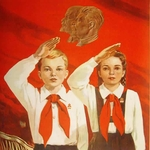 The Great Patriotic War and the Postwar Years
The Great Patriotic War and the Postwar Years
E.N. Benevalenskaya
Pioneer Organization of the Altai Territory and the Formation of Soviet Identity in 1945–1955
The 100th anniversary of the Pioneers, celebrated this year, actualizes the problem of the role of this children’s organization in the history of our country. In the article, for the first time, on the basis of regional materials, the mechanisms of implementing the state project for the formation of Soviet identity in the activities of the pioneer associations of Altai in 1945–1955 are considered. The value of the considered practices of constructing civic identity lies in the fact that their implementation was part of a large-scale and unique experiment in the world of incorporating Soviet rituals and traditions into the everyday life of children and youth. The methodological basis of the work was social-constructivist, process-relational and cultural approaches applied to the study of the phenomenon of memory in the problem field of Memory Studies. The source base of the article includes the normative documents of the Central Committee of the All-Union Leninist Communist Youth Union, office materials of its organizations in the region from the funds of the State Archive of the Altai Territory. The analysis of the reports of the departments of pioneers and school youth of the Komsomol was supplemented by the study of information and certificates on inspections of the work of children’s associations by the regional, city and district committees of the Communist Party and the involvement of press materials about their activities in Altai. During the study, in relation to the goals of the ideological policy of the Soviet Union, the tasks and directions of the restored pioneer movement were revealed. The process of introducing all-Soviet symbols, rituals and commemorations into children’s everyday life, called to instill civic identity, is shown. It has been established that turning to the past was an important mechanism for the formation of patterns of self-identification of the younger generation in the pioneer organization of the Altai Territory. Positive factors in the formation of life orientations for children and teenagers were examples of the fates of veterans of two wars, pilots, scientists and researchers, and highly qualified specialists from enterprises of the region.
Publishing: 28/12/2022
How to cite: Benevalenskaya E.N. Pioneer Organization of the Altai Territory and the Formation of Soviet Identity in 1945–1955 // Historical Courier, 2022, No. 6 (26), pp. 124–134. [Available online: http://istkurier.ru/data/2022/ISTKURIER-2022-6-09.pdf]
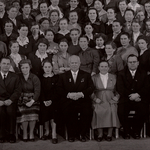 Late Soviet Period
Late Soviet Period
T.M. Petrova
Critical Discourse Analysis of Soviet Diaries and Letters to the Authorities as an Instrument for Studying Public Opinion about N.S. Khrushchev (1953–1964)
The article analyzes discourses of diaries and letters, which contain information about attitude of the population to N.S. Khrushchev. With the help of critical discourse analysis of N. Fairclough, sources are considered as communicative events. The author concludes that the presence of traditional and new discourses in diaries and letters indicates changes in the perception of the head of state in the minds of population. More traditional letters contain discourses of past times (peaceful, paternalistic), while the distinctive feature of diaries are discourses of personal characteristics and public approval, which are signs of the “thaw” indicating the expansion of boundaries of what is permissible in relation to the leader’s assessments. The latter became possible due to the transformations, which were initiated by Khrushchev. However, their inconsistency led to the emergence of a critical discourse, present both communicative events and caused by the disappointment of people with Khrushchev as head of state and his policy.
RFBR Grant 20-59-44008 Mong_a “World and Russian Mongolian Studies: National Schools, Concepts, Personalities”.
Publishing: 28/12/2022
How to cite: Petrova T.M. Critical Discourse Analysis of Soviet Diaries and Letters to the Authorities as an Instrument for Studying Public Opinion about N.S. Khrushchev (1953–1964) // Historical Courier, 2022, No. 6 (26), pp. 135–145. [Available online: http://istkurier.ru/data/2022/ISTKURIER-2022-6-10.pdf]
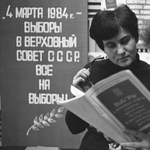 Late Soviet Period
Late Soviet Period
A.A. Fokin
“Automatics don’t Suit Us”: Elections as an Element of the Confrontation Between Socialism and Capitalism in the Cold War Era
The turn of the 1950s and 1960s was marked by the desire to build a dialogue between the East and the West. The USSR was showing its openness and willingness to compete with the West not only with tanks, planes and missiles, but also on the symbolic field. One such aspect of the competition, which was supposed to prove the superiority of socialism, was the Soviet elections. Soviet propaganda actively emphasized that genuine democracy existed only in the USSR. In capitalist countries, various censors and other restrictions prevented the population from fully expressing its political will. During this period, the struggle for true democracy fitted well with the general achievements of the USSR in the exploration of the space and the atom, and successes in science and technology were supposed to support the advantages of the model of democracy which was being implemented within the Soviet regime. At the same time, it is important to note that the Soviet leadership sought not to hide the peculiarities of Soviet elections, such as almost 100 % turnout and no alternatives, but rather to show the progressive nature of the Soviet electoral system. The article analyzes a meeting in 1962 between representatives of the Central Election Commission of the USSR and students of courses for activists of the trade union movement in Asia, Africa, and Latin America. It shows how the representatives of the Soviet system sought to demonstrate the advantage of the Soviet electoral system and the disadvantages of the Western one. In this way the discussion of Soviet diplomacy is considered in the context of the Cold War.
The work was carried out with the financial support of RFBR grant No. 20-09-00218 “Practices of Interaction Between Government and Society in the Late Soviet Period (1956–1985)”.
Publishing: 28/12/2022
How to cite: Fokin A.A. “Automatics don’t Suit Us”: Elections as an Element of the Confrontation Between Socialism and Capitalism in the Cold War Era // Historical Courier, 2022, No. 6 (26), pp. 146–153. [Available online: http://istkurier.ru/data/2022/ISTKURIER-2022-6-11.pdf]
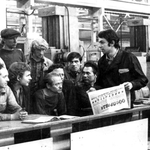 Late Soviet Period
Late Soviet Period
I.N. Strekalov
“Letters to power” of Soviet Citizens During the Creation of the Constitution of the USSR in 1977: “Breaking” the Template and Unexpected “Revelations”
The research concentrates on the letters from the Soviet citizens demonstrating a non-standard approach to the creation of the Constitution of the USSR in 1977. The documents of the funds of the Supreme Soviet of the USSR and the sub-department of letters of the General Department of the Central Committee of the CPSU were studied. The author concludes that a number of Soviet citizens were to abandon standard forms of appeals to power and even to make a “revelation” in dialogue with her, which speaks in favor of the existence of differences in thinking of the Soviet society.
The article was prepared as part of the RFBR grant project No. 20-09-00218 “Practices of Interaction Between Government and Society in the Late Soviet Period (1956–1985)”.
Publishing: 28/12/2022
How to cite: Strekalov I.N. “Letters to power” of Soviet Citizens During the Creation of the Constitution of the USSR in 1977: “Breaking” the Template and Unexpected “Revelations” // Historical Courier, 2022, No. 6 (26), pp. 154–163. [Available online: http://istkurier.ru/data/2022/ISTKURIER-2022-6-12.pdf]
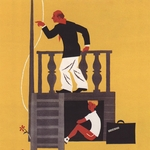 Late Soviet Period
Late Soviet Period
T.V. Savina
Speaking Bolshevik? The Language of a Communist Party Member in Soviet Prose of the “Thaw” Period
Based on the analysis of the “Thaw” period Soviet prose, the article examines the question of destruction of the official Soviet language canon. The article concludes that the destruction of the external form of the language canon occurred at the expense of satirical techniques, while the semantic indivisibility of the language canon was undermined through irony: desacralization of the “meta-text” opened the possibility of its de-ideologization. However, the main ideologemes and myths proved resistant to destruction, since they were not external linguistic markers, but were embedded in the linguistic consciousness of a Soviet man. The Soviet Union was a space modeled by political texts. This space along with the ideologically generalized world-view of “Soviet people” were still not questioned in the literature of the “Thaw” period.
Publishing: 28/12/2022
How to cite: Savina T.V. Speaking Bolshevik? The Language of a Communist Party Member in Soviet Prose of the “Thaw” Period // Historical Courier, 2022, No. 6 (26), pp. 164–179. [Available online: http://istkurier.ru/data/2022/ISTKURIER-2022-6-13.pdf]
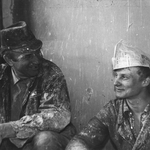 Late Soviet Period
Late Soviet Period
N.A. Belyakova, V.P. Klyueva
Outcasts or Honest Workers: Diversity of Representations of Evangelical Believers in the Late USSR
The article analyzes the representations of believers in the USSR during the Brezhnev period, and the correlation of religious views with everyday life and Soviet ideology. Authors used field materials collected in religion communities of the former Soviet Union in the 2010s. The main method of data collection is the biographical narrative interview method. These narratives were supplemented and verified by documents of government authorities from central and regional archives and ego-documents of believers (testimonies, memoirs, and letters). The materials of oral history show the position of the believers themselves, who talk about their Soviet experience, and about various practices of exclusion and inclusion. Believers in the Soviet media were portrayed as a marginal and isolated group. The Evangelicals themselves, in their memoirs, describe “feats of faith” and ways of surviving in an anti-religious environment. Modern interviews show the versatility of Soviet society in the period of late socialism and the active involvement of evangelical believers in it. Latent discrimination contributed to the shaping of their identity. The value of their labor potential compensated for their social discrimination as “sectarians”. At the same time, believers learned and practiced Soviet values (ideals) and norms, which is reflected in their speech and behavior patterns. They, like the majority of Soviet people, demonstrated a performative shift in relation to Soviet rituals and practices. It is concluded that in the late USSR, evangelical believers were an organic part of the Soviet social diversity.
Publishing: 28/12/2022
How to cite: Beliakova N.A., Kliueva V.P. Outcasts or Honest Workers: Diversity of Representations of Evangelical Believers in the Late USSR // Historical Courier, 2022, No. 6 (26), pp. 180–194. [Available online: http://istkurier.ru/data/2022/ISTKURIER-2022-6-14.pdf]
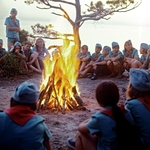 Late Soviet Period
Late Soviet Period
A.D. Popov, E.A. Popova
Fire, Water and Sonorous Bugles: Ritualized Symbolic Practices of Artek in the Late Soviet Period
The article analyses ritualized symbolic practices characteristic of the All-Union pioneer camp Artek in the second half of the 1950s – 1980s. Using of the concept of “the ritualized symbolic practice”, proposed by the American sociologist D. Knottnerus, allows the authors to get away from the need for a theoretical separation of related concepts “ritual,” “rite,” “custom,” “tradition,” “ceremony” and makes it possible for the first time to consider the whole set of emotionally loaded algorithms (scenarios) of social actions practiced in Artek, implemented in accordance with certain programs (schemes). Another advantage of this approach is the ability to build a hierarchy of Artek ritualized symbolic practices: from intra-group interaction of several people to large-scale events designed for a global audience. As a result, the authors conclude that, despite the very favorable conditions for ideological and educational influence, Artek also showed ambiguous phenomena characteristic of late Soviet society as a whole: excessive ideologization and formalism, “shadow” practices, including those aimed at moving to “zones of deterritorialization”.
Funding: The study is supported by Russian Science Foundation, project No. 20-18-00342.
Publishing: 28/12/2022
How to cite: Popov A.D., Popova E.A. Fire, Water and Sonorous Bugles: Ritualized Symbolic Practices of Artek in the Late Soviet Period // Historical Courier, 2022, No. 6 (26), pp. 195–206. [Available online: http://istkurier.ru/data/2022/ISTKURIER-2022-6-15.pdf]
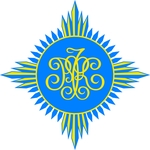 Late Soviet Period
Late Soviet Period
O.N. Shelegina
Public Organizations of Late Socialism: The Initial Stage of the Activity of the Siberian Branches of the Soviet/Russian Culture Fund
The study of the history of the Soviet/Russian Culture Fund and its regional branches as a public organization of the late socialism period is updated. For the first time the historiographic resource for the study of the topic is analyzed, the activity of Novosibirsk branch of the Culture Fund in 1987–1996 is reconstructed on the basis of archival materials. The general directions and peculiarities of the work of Siberian branches of the Culture Fund: Omsk, Novosibirsk, Khakass are characterized. The results of integration in the sphere of heritage development, military-historical commemoration, projects and cultural initiatives are shown.
Publishing: 28/12/2022
How to cite: Shelegina O.N. Public Organizations of Late Socialism: The Initial Stage of the Activity of the Siberian Branches of the Soviet/Russian Culture Fund // Historical Courier, 2022, No. 6 (26), pp. 207–220. [Available online: http://istkurier.ru/data/2022/ISTKURIER-2022-6-16.pdf]
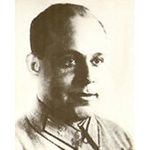 Open Archives
Open Archives
A.G. Teplyakov
M.P. Schrader’s Memories “Life of the Officer of Secret Police” (Part 5)
This publication is another part of the extensive memoirs of M.P. Schrader (1902-1978) "The Life of a Chekist operative". A significant part of the text published here relates to Schrader's work in the currency group of the OGPU Economic Management in the late 1920s. The first three parts of Schrader's memoirs were published in the journal "Historical Courier" No. 1 (3) and No. 6 (8) for 2019, No. 1 (9) for 2020. The fourth part is published in the collection "Problems of the history of society, state and law: collection of scientific papers (Yekaterinburg, 2021. Issue 14).
Publishing: 28/12/2022
How to cite: Teplyakov A.G. M.P. Schrader’s Memories “Life of the Officer of Secret Police” (Part 5) // Historical Courier, 2022, No. 6 (26), pp. 221–250. [Available online: http://istkurier.ru/data/2022/ISTKURIER-2022-6-17.pdf]
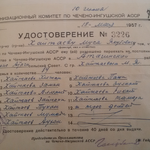 Open Archives
Open Archives
N.N. Ablazhey, A.T. Kazbekova
Between Exile and Repatriation: Vainakhs and the Khrushchev “Thaw”
The consequences of deportation, exile and repatriation as the example of the Soviet migration policy are analyzed in this paper based on the data referring to the Chechen and Ingush people. Total deportation and the twelve-years exile turned out to be counterproductive measures, as they led to ethnic consolidation and allowed the “punished people” to resist not only foreign cultural influence, but also Sovietization. In the context of liberalization and the rejection of mass repressions, the authorities tried to return the Vainakhs to the Soviet system restoring their national autonomy and allowing repatriation to the historical homeland. The authors attempt illustrating the updated paradigm of the dialogue between the authorities and the ethnic group, and the boundaries of the communicative space. The publication brings into the field of research two documents from the thematic case on the return of the Chechen-Ingush population to the CHI ASSR (Chechen-Ingush Automous Soviet Socialist Republic) in 1957, deposited in the fund of the Central Committee of the Communist Party of Kazakhstan and stored in the Archive of the President of the Republic of Kazakhstan.
Publishing: 28/12/2022
How to cite: Ablazhey N.N., Kazbekova A.T. Between Exile and Repatriation: Vainakhs and the Khrushchev “Thaw” // Historical Courier, 2022, No. 6 (26), pp. 251–276. [Available online: http://istkurier.ru/data/2022/ISTKURIER-2022-6-18.pdf]
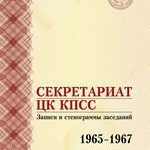 The World of Books
The World of Books
M.A. Simonov
At the Beginning of a Long Epoch
The article is a review of two documentary publications (Tomilina, N.G., Prozumenshchikov, M.Y., Jalilov, T.A., Pivovarov, N.Y. (Comp.). (2020). Secretariat of the Central Committee of the CPSU. Recordings and Transcripts of Meetings of 1965–1967. Moscow, IstLit, 2020. 944 p.; Prozumenshchikov, M.Yu., Jalilov, T.A., Pivovarov, N.Yu. (Comp.). (2020). Secretariat of the Central Committee of the CPSU. Working Notes and Minutes of Meetings. 1968. Moscow, IstLit. 968 p.). The corpuses of records and working materials of the Secretariat of the Central Committee of the CPSU for 1966–1968 are a full-stock edition of the documents of one of the two highest leadership bodies of the Communist Party, along with the Politburo. The review reveals the informational potential of the publications. First of all, they reflect the formal organization of the supreme party power at the beginning of the Brezhnev leadership of the USSR, and also show the decision-making process of its members. In addition, the collections under consideration contain material about almost all areas of the country’s life. The review pays special attention to the reflection of the Soviet-Chinese contradictions in the documents.
Publishing: 28/12/2022
How to cite: Simonov M.A. At the Beginning of a Long Epoch // Historical Courier, 2022, No. 6 (26), pp. 277–285. [Available online: http://istkurier.ru/data/2022/ISTKURIER-2022-6-19.pdf]
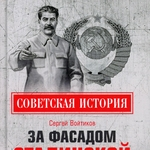 The World of Books
The World of Books
I.N. Strekalov
Book Review: Voytikov S.S. Behind the Facade of the Stalin Constitution. The Soviet Parliament from Kalinin to Gromyko. M., Veche, 2021. 464 p.
A review of the book by S.S. Voytikov on the history of the Supreme Soviet of the USSR is presented in the following text. The book describes the historical age from the time of the formation of this state body, the first years of Soviet power, until the mid-1980s. The book provides information about the work of the structural units of the highest legislative body of a power in the Soviet Union. Biographical characteristics of its leaders, from M.I. Kalinin to A.A. Gromyko, are presented too; their personal role in the work of this institution is revealed. The author comes to the conclusion that the Supreme Soviet of the USSR turned out to be an unviable institution of power in the conditions of the dominance of the party rules in the country. Such a conclusion is quite traditional for historiography, although it is based on the introduction of some previously unpublished sources. The position expressed by the author makes it possible to continue the discussion about the real intentions and capabilities of the USSR leadership to “revive” the work of the country’s highest authority.
The article was prepared as part of the RFBR grant project No. 20-09-00218 “Practices of Interaction Between Government and Society in the Late Soviet Period (1956–1985)”.
Publishing: 28/12/2022
How to cite: Strekalov I.N. Book Review: Voytikov S.S. Behind the Facade of the Stalin Constitution. The Soviet Parliament from Kalinin to Gromyko. M., Veche, 2021. 464 p. // Historical Courier, 2022, No. 6 (26), pp. 286–291. [Available online: http://istkurier.ru/data/2022/ISTKURIER-2022-6-20.pdf]
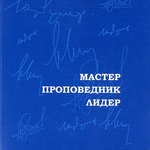 The World of Books
The World of Books
I.S. Kuznetsov
The Scientists about the Scientists: Worlds and Myths of Novosibirsk Akademgorodok
The article analyzes the most notable new publications about the history of Siberian Branch of the Russian Academy of Sciences, Novosibirsk Scientific Center. Among them are a monograph by I.A. Kraineva, a book by E.V. Vishnevsky about M.A. Lavrentiev, memoirs by V.D. Ermikov and a collection about N.A. Pritvits. The author comes to the conclusion that the own history of Akademgorodok of Novosibirsk as an unique social and historical phenomenon is still clearly insufficiently researched. The author agrees with the high assessment of the Siberian city of Science, its unique intellectual and spiritual atmosphere. At the same time, the illegality of his idealization and apologetics is emphasized, since here, along with outstanding achievements, ambiguous, contradictory pages took place.
Publishing: 28/12/2022
How to cite: Kuznetsov I.S. The Scientists about the Scientists: Worlds and Myths of Novosibirsk Akademgorodok // Historical Courier, 2022, No. 6 (26), pp. 292–304. [Available online: http://istkurier.ru/data/2022/ISTKURIER-2022-6-21.pdf]
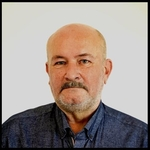 Ad Memoriam
Ad Memoriam
In Memory of Doctor of Historical Sciences Alexander Khristianovich Elert
On November 26, 2022, Alexander Khristianovich Elert passed away.



